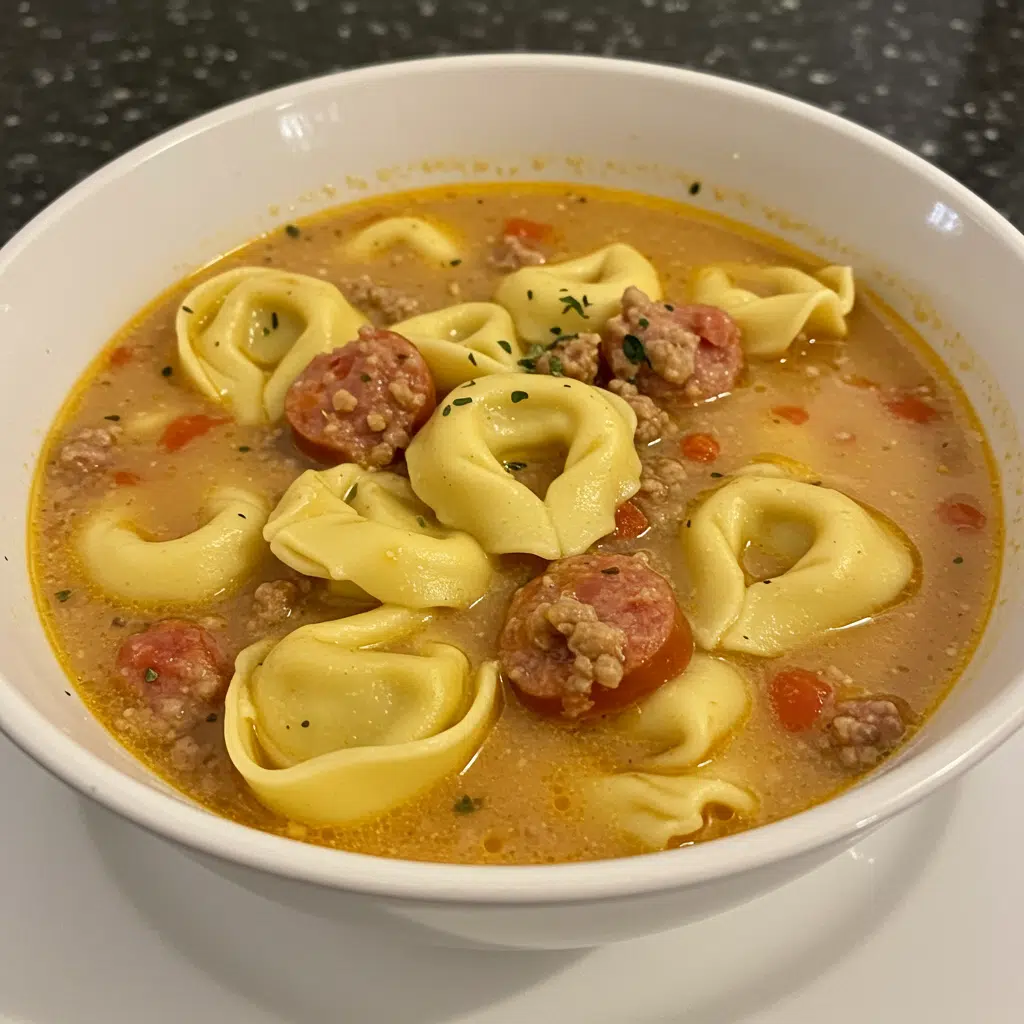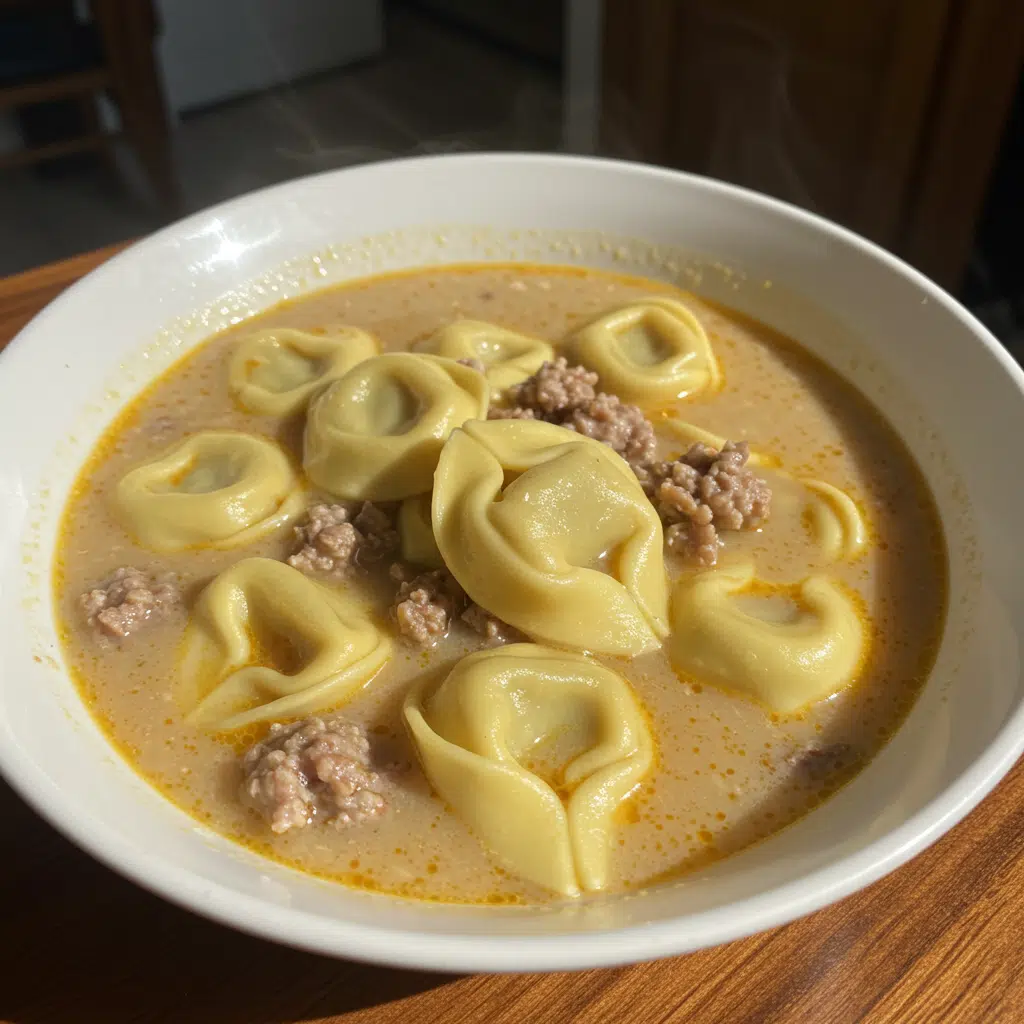Italian Sausage Tortellini Soup is a hearty, comforting meal made with flavorful sausage, cheesy pasta, and a rich, creamy tomato broth. With minimal prep and just 40 minutes from start to finish, it’s the perfect weeknight dinner that the whole family will love. Packed with veggies and big flavor, this soup is both cozy and satisfying.
Love More Tortellini Recipes? Try My Cheesesteak Tortellini in Provolone Sauce or this Butternut Squash Sausage Tortellini Soup next.

Why You’ll Love This Recipe
This tortellini soup is the ultimate comfort food, warming you from the inside out with every spoonful. The combination of hearty Italian sausage, cheesy pasta, and creamy tomato broth makes it both filling and flavorful, perfect for family dinners. With just a bit of chopping and browning, prep time is minimal, so you can have it on the table in about 40 minutes. It’s a cozy, satisfying meal that beats takeout any night of the week.
Print
Italian Sausage Tortellini Soup
- Total Time: 40 minutes
- Yield: About 8 cups
Description
This hearty Italian Sausage Tortellini Soup combines savory sausage, cheese-filled tortellini, and fresh spinach in a rich, creamy tomato broth – pure comfort in a bowl!
Ingredients
For the Soup Base:
- 16 oz Italian sausage (ground or removed from casings)
- ½ medium onion, finely chopped
- 2 stalks celery, finely chopped
- 2 tablespoons all-purpose flour
- 3–4 cloves garlic, minced
- 4 cups chicken broth
- 28 oz can diced tomatoes (with juices)
- ¼ teaspoon Italian seasoning
For the Finishing Touches:
- 2 generous cups refrigerated cheese tortellini
- 1 cup heavy cream
- 2 cups packed fresh baby spinach (optional but recommended!)
- Salt and black pepper, to taste
Instructions
Brown the sausage in a large soup pot or Dutch oven over medium-high heat for 7–10 minutes, breaking it into nickel-sized pieces and letting it sit undisturbed for a few minutes at a time so it develops deep golden-brown caramelization. Transfer to a paper towel-lined plate, drain excess fat, and keep about 1 tablespoon in the pot to build the flavor base for the soup.
Add diced onion and celery to the pot and cook over medium-high heat for 4–5 minutes, stirring occasionally, until the onions are translucent and the celery is softened but not mushy. Let the vegetables absorb the sausage fond as they cook, creating a sweet, savory base that deepens the soup’s flavor.
Stir in the flour and garlic, cooking for 1 minute while stirring constantly until the flour loses its raw taste and the garlic is fragrant but not browned. This creates a thick, toasty roux that will thicken the soup and carry the sausage and vegetable flavors into the broth.
Slowly whisk in the chicken broth in stages, starting with a cup at a time, to create a smooth, lump-free base. Scrape up the browned bits as you go—this deglazing adds rich flavor while transforming the mixture from thick and pasty to silky and uniform.
Stir in the diced tomatoes with their juices, Italian seasoning, and the cooked sausage along with any accumulated juices, then bring the soup to a gentle boil. This step melds the flavors, adds color and body, and lets the sausage finish cooking while infusing the broth with richness.
Add the tortellini and simmer gently for about 5 minutes, checking at 4 minutes to avoid overcooking. They’re ready when they float to the top and are tender with a slight firmness, so stir gently and watch closely to keep them from turning mushy.
Stir in the cream over a gentle simmer for 5 minutes, then add spinach (if using) just before serving so it wilts and brightens the soup. Taste and season with salt and freshly ground black pepper to balance the richness and bring out the flavors.
Notes
Brown the sausage in two batches if your pot feels crowded. Overcrowded meat steams instead of browning, and you lose all that delicious caramelization that adds flavor depth. Better to take an extra few minutes than have bland soup that tastes like it came from a can.
Scrape up the brown stuff on the bottom when you add broth – that’s flavor gold sitting there waiting to be incorporated. Those browned bits are called fond, and they contain concentrated flavor that professional chefs never waste. Use your wooden spoon to scrape them loose as you add the liquid.
Let cream sit out while you prep so it’s not ice cold when you add it. Cold cream hitting hot soup can curdle, creating an unappetizing grainy texture that’s hard to fix. Room temperature cream incorporates smoothly and creates that silky finish we’re after.
Grate fresh parmesan right into each bowl if you want to get fancy. The residual heat melts it slightly and creates an extra layer of creamy richness that makes everyone think you’re a gourmet cook. Use the real stuff – not the pre-grated kind that tastes like sawdust.
- Prep Time: 10 minutes
- Cook Time: 30 minutes
- Category: Soup
- Method: Stovetop
- Cuisine: Italian-American
Ingredient List
For the Soup Base:
- 16 oz Italian sausage (ground or removed from casings)
- ½ medium onion, finely chopped
- 2 stalks celery, finely chopped
- 2 tablespoons all-purpose flour
- 3–4 cloves garlic, minced
- 4 cups chicken broth
- 28 oz can diced tomatoes (with juices)
- ¼ teaspoon Italian seasoning
For the Finishing Touches:
Salt and black pepper, to taste
2 generous cups refrigerated cheese tortellini
1 cup heavy cream
2 cups packed fresh baby spinach (optional but recommended!)
Why These Ingredients Work Together
The sausage does most of the seasoning work since it’s already loaded with herbs and spices like fennel, garlic, and oregano. This means you don’t need a cabinet full of seasonings to get incredible flavor. I learned this the hard way after making bland soup with plain ground pork thinking I could season it myself.
Italian sausage makers have spent generations perfecting the balance of spices. The fennel gives it that distinctive Italian flavor, the garlic adds depth, the oregano brings earthiness, and usually there’s a touch of red pepper for background heat. When you brown the sausage properly, all these flavors develop and concentrate, creating the flavor foundation for the entire soup.
Flour thickens everything up so you don’t end up with watery soup that disappoints everyone. Just two tablespoons transforms the broth from thin to perfectly creamy without being heavy. It also helps the cream incorporate smoothly instead of floating on top in weird patches.
The flour serves another crucial purpose – it helps emulsify the fat from the sausage with the liquid ingredients. This creates a more cohesive soup where every spoonful has consistent flavor and texture. Without it, you’d have thin broth with pools of oil on top.
Fresh tortellini stays tender better than the frozen stuff and cooks more evenly. Plus, it doesn’t get mushy if you accidentally let the soup simmer too long while you’re distracted by kids asking for help with homework.
The pasta shapes matter more than you might think. Tortellini’s twisted shape and hollow center trap the flavorful broth, so every bite delivers maximum taste. The cheese filling adds richness and protein, making this soup substantial enough to serve as a complete meal rather than just a starter.
The diced tomatoes add brightness and acidity that cuts through all that creamy richness. They also give the soup a beautiful color that looks appetizing instead of just beige. The acidity is particularly important – without it, this soup would be overwhelmingly rich and one-dimensional.
Tomatoes also add umami, that savory depth that makes food taste more satisfying. The natural glutamates in tomatoes enhance all the other flavors in the soup, making the sausage taste more meaty, the cheese more complex, and the herbs more aromatic.
Heavy cream makes everything luxurious and restaurant-quality. Don’t try to substitute milk or half-and-half – you need the fat content to prevent curdling and get that silky texture that makes people think you’re a better cook than you actually are.
The spinach serves multiple purposes beyond just adding color. It provides a slight mineral flavor that balances the richness, adds nutrition that makes you feel less guilty about the cream, and gives the soup visual appeal. Nutritionally, it’s loaded with iron, folate, and vitamins A and K, though let’s be honest – we’re not eating this soup for the health benefits.
Essential Tools and Equipment
A big soup pot or Dutch oven (at least 6 quarts) is needed to cook the soup and stir without spilling.
A heavy-bottomed pot, preferably stainless steel or enameled cast iron, ensures even heat distribution and prevents burning.
A wooden spoon is essential for stirring and breaking up sausage without scratching the pot.
A flat-edged wooden spoon works best for scraping browned bits, while a rounded wooden spoon is better for stirring liquids.
Paper towels are necessary for draining grease and cleaning up during cooking.
A sharp knife, ideally an 8-inch chef’s knife, is used for chopping vegetables evenly.
A whisk, preferably a balloon whisk, helps incorporate broth smoothly and prevent lumps.
A sturdy everyday whisk is recommended for deglazing and mixing in thicker stages of cooking.
A ladle is used for serving soup neatly and with portion control.
A stainless steel ladle (about ¾ cup capacity) is ideal for durability and heat resistance.
How To Make Italian Sausage Tortellini Soup
Brown the Sausage
Brown the sausage in a large soup pot or Dutch oven over medium-high heat for 7–10 minutes, breaking it into nickel-sized pieces and letting it sit undisturbed for a few minutes at a time so it develops deep golden-brown caramelization. Transfer to a paper towel-lined plate, drain excess fat, and keep about 1 tablespoon in the pot to build the flavor base for the soup.
Cook Vegetables
Add diced onion and celery to the pot and cook over medium-high heat for 4–5 minutes, stirring occasionally, until the onions are translucent and the celery is softened but not mushy. Let the vegetables absorb the sausage fond as they cook, creating a sweet, savory base that deepens the soup’s flavor.
Add Flour and Garlic
Stir in the flour and garlic, cooking for 1 minute while stirring constantly until the flour loses its raw taste and the garlic is fragrant but not browned. This creates a thick, toasty roux that will thicken the soup and carry the sausage and vegetable flavors into the broth.
Add Broth
Slowly whisk in the chicken broth in stages, starting with a cup at a time, to create a smooth, lump-free base. Scrape up the browned bits as you go—this deglazing adds rich flavor while transforming the mixture from thick and pasty to silky and uniform.
Add Tomatoes and Sausage
Stir in the diced tomatoes with their juices, Italian seasoning, and the cooked sausage along with any accumulated juices, then bring the soup to a gentle boil. This step melds the flavors, adds color and body, and lets the sausage finish cooking while infusing the broth with richness.
Cook the Tortellini
Add the tortellini and simmer gently for about 5 minutes, checking at 4 minutes to avoid overcooking. They’re ready when they float to the top and are tender with a slight firmness, so stir gently and watch closely to keep them from turning mushy.
Finish with Cream and Spinach
Stir in the cream over a gentle simmer for 5 minutes, then add spinach (if using) just before serving so it wilts and brightens the soup. Taste and season with salt and freshly ground black pepper to balance the richness and bring out the flavors.

You Must Know
Keep about a tablespoon of the sausage grease in the pot to cook the vegetables, since it holds the spices and adds depth. Draining it all leaves the soup bland, while that small amount infuses the whole dish with rich, savory flavor.
Personal Secret: Brown the sausage well to develop caramelized bits through the Maillard reaction, which adds depth and complexity. Pale sausage won’t deliver the same rich flavor your soup needs.
Pro Tips & Cooking Hacks
Brown the sausage in two batches if your pot feels crowded. Overcrowded meat steams instead of browning, and you lose all that delicious caramelization that adds flavor depth. Better to take an extra few minutes than have bland soup that tastes like it came from a can.
Scrape up the brown stuff on the bottom when you add broth – that’s flavor gold sitting there waiting to be incorporated. Those browned bits are called fond, and they contain concentrated flavor that professional chefs never waste. Use your wooden spoon to scrape them loose as you add the liquid.
Let cream sit out while you prep so it’s not ice cold when you add it. Cold cream hitting hot soup can curdle, creating an unappetizing grainy texture that’s hard to fix. Room temperature cream incorporates smoothly and creates that silky finish we’re after.
Grate fresh parmesan right into each bowl if you want to get fancy. The residual heat melts it slightly and creates an extra layer of creamy richness that makes everyone think you’re a gourmet cook. Use the real stuff – not the pre-grated kind that tastes like sawdust.
Flavor Variations & Suggestions
For a balanced flavor that pleases everyone, use half sweet and half hot sausage—the sweet provides a flavorful base while the hot adds just a hint of heat. Adding diced carrots with the celery brings natural sweetness, color, and even cooking, while fresh basil added at the end gives a bright, authentic Italian aroma. Sun-dried tomatoes contribute extra tomato punch and visual interest, and using seasoned turkey sausage or a parmesan rind can enhance depth and umami in the soup.
White beans make the soup heartier, adding protein and fiber, while different pasta shapes like ravioli or shells can substitute for tortellini if needed. Mushrooms bring earthiness and umami, especially when sautéed with the aromatics, releasing concentrated flavor as they cook. Overall, these small adjustments layer flavors and textures, making the soup rich, complex, and visually appealing.
Make-Ahead Options
Make the soup through step 5 and refrigerate for up to two days—this actually enhances the flavors as the sausage, tomatoes, and herbs meld together. When ready to serve, gently reheat over medium heat and add the tortellini, cream, and spinach fresh for the best texture and taste.
For longer storage, freeze the base (without pasta or cream) in flat freezer bags for up to three months; thaw slowly in the fridge before finishing the soup. Leftovers can be reheated with extra broth to restore the original consistency, and single-serving portions in glass containers make quick, flavorful meals for busy days.
Recipe Notes & Baker’s Tips
Fresh refrigerated tortellini cooks more evenly and holds its shape better than frozen, giving the soup a tender, consistent texture. Frozen tortellini works in a pinch but requires longer cooking and gentle stirring to prevent bursting, and may release extra starch that thickens the soup.
Use high-quality chicken broth with real gelatin for body and richness, and adjust soup thickness by simmering uncovered rather than adding extra flour or cornstarch. Add cream slowly over gentle heat to avoid curdling, and balance fat from the sausage with olive oil if needed. Finally, check your Italian seasoning for freshness—old or weak herbs can noticeably dull the soup’s flavor.
Serving Suggestions
Crusty bread is a must for dipping—warm a bakery loaf in a 350°F oven for 5–10 minutes while the soup finishes cooking to get that perfect crunch. Look for bread with a sturdy crust and open crumb, like sourdough, Italian, or French baguettes, and avoid soft sandwich bread that falls apart. Warm bowls in a 200°F oven for a few minutes so the soup stays hot longer and delivers a restaurant-quality experience at home.
Finish each bowl with freshly grated Parmesan and a crack of black pepper, letting the cheese melt slightly into the soup for ribbons of flavor. Pair with a simple Caesar salad for a complete meal—the crisp romaine and tangy dressing balance the rich, creamy soup beautifully. Making the salad while the soup simmers ensures everything is perfectly timed and ready to serve together.
This soup is perfect for entertaining or family dinners, impressively simple and comforting at the same time. Even picky eaters will often ask for seconds thanks to the small diced vegetables, cheesy tortellini, and familiar flavors. Serve with cloth napkins for a touch of elegance, and enjoy a cozy, stress-free meal that feels like a warm hug from the inside out.

How to Store Your Italian Sausage Tortellini Soup
Refrigerate leftovers in covered containers for up to four days, adding a splash of broth when reheating to restore consistency. Freeze the soup base without tortellini and cream, then add them fresh after thawing for the best texture. Portion individual servings in glass or plastic containers for easy reheating, meal prep, and portion control, making sure the soup cools completely before storing.
Allergy Information
This recipe contains dairy from the cream and cheese-filled tortellini, making it unsuitable for lactose-intolerant family members without substitutions. The tortellini are the main source of dairy, often filled with ricotta or mozzarella, and the pasta may also contain eggs.
Dairy-free version: Replace the cream with full-fat coconut milk and use dairy-free tortellini, such as those from Kite Hill. The coconut milk provides similar richness, though the flavor will differ slightly from the original.
Gluten-free version: Use gluten-free tortellini and replace the flour with half the amount of cornstarch mixed with cold water. Add the cornstarch slurry gradually while stirring to ensure a smooth, lump-free soup.
Questions I Get Asked A Lot
Can I use ground turkey instead of Italian sausage?
Use Italian-seasoned turkey sausage for best flavor, as plain ground turkey is too mild on its own. Even with seasoned turkey, you may need to add a little extra Italian seasoning to compensate for its milder taste compared to pork.
What if I can’t find Italian sausage?
Use regular ground pork and add extra Italian seasoning, fennel seeds, garlic powder, and red pepper flakes to taste. Start with an extra teaspoon of Italian seasoning and adjust from there.
How do I prevent the tortellini from getting mushy?
Don’t overcook them, and if making ahead, add fresh tortellini when reheating rather than storing them in the soup.
Can I use different pasta shapes?
Yes, though the cooking times will vary. Small shapes like ditalini or shells work well, as do cheese ravioli. Avoid long pasta like spaghetti or linguine, which are difficult to eat in soup.
💬 Tried this recipe? Leave a comment and rating below! I’d love to hear about your favorite variations and how your family loved it!

